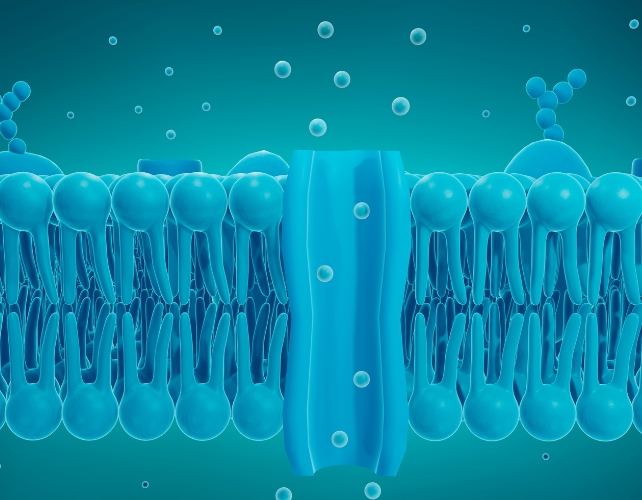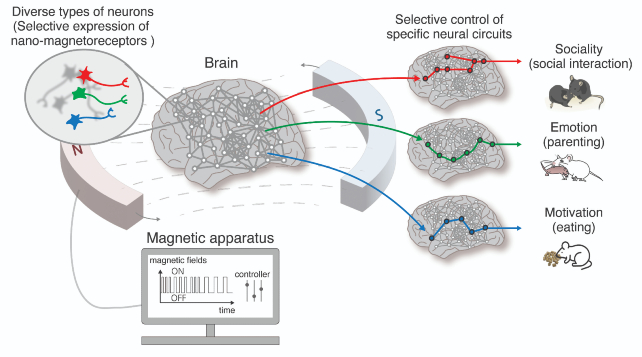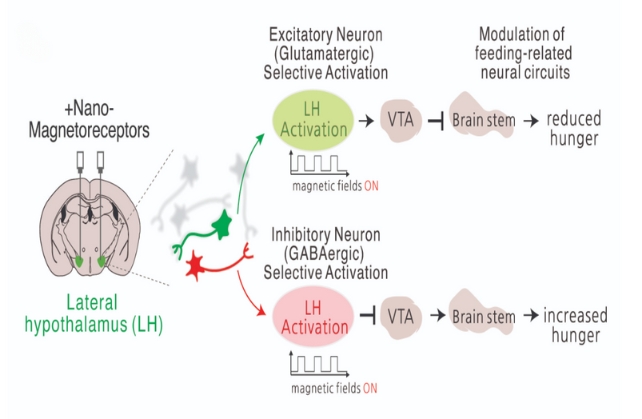ARTICLE AD
 Maternal behaviors in female mice were remotely switched on in brain control experiment. (slowmotiongli/Getty Images)
Maternal behaviors in female mice were remotely switched on in brain control experiment. (slowmotiongli/Getty Images)
At the mere flick of a magnetic field, mice engineered with nanoparticle-activated 'switches' inside their brains were driven to feed, socialize, and act like clucky new mothers in an experiment designed to test an innovative research tool.
While 'mind control' animal experiments are far from new, they have generally relied on cumbersome electrodes tethering the subject to an external system, which not only requires invasive surgery but also sets limits on how freely the test subject can move about.
In what is claimed to be a breakthrough in neurology, researchers from the Institute for Basic Science (IBS) in Korea have developed a method for targeting pathways in the brain using a combination of genetics, nanoparticles, and magnetic fields.
They call the technology Nano-MIND, an acronym for Magnetogenetic Interface for NeuroDynamics. And while mind-control is a coarse but relatively accurate way of describing it, the system in its current form is intended to provide researchers with a means of remotely activating neural circuits for a range of research applications.
"This is the world's first technology to freely control specific brain regions using magnetic fields," says Jinwoo Cheon, senior author and director of the IBS Center for Nanomedicine.
"We expect it to be widely used in research to understand brain functions, sophisticated artificial neural networks, two-way BCI [brain-computer interface] technologies, and new treatments for neurological disorders."
Magnetic stimulation is an emerging field of research in neurology, where washing the brain with pulses of electromagnetism broadly massages whole regions into subtly changing their behavior.
To target specific circuits, the researchers took a leaf out of another field of research called optogenetics, which genetically engineers mechanisms into cells that can be readily activated by a light source.
 Illustration of an ion channel (center) in a cell membrane. Ion channels facilitate electrical signaling in the brain by allowing specific ions (like sodium, potassium, and calcium) to pass through the membrane. (Sciencephoto/Canva Pro)
Illustration of an ion channel (center) in a cell membrane. Ion channels facilitate electrical signaling in the brain by allowing specific ions (like sodium, potassium, and calcium) to pass through the membrane. (Sciencephoto/Canva Pro)In this case, the team integrated ion channels into targeted populations of brain cells in mice.
Instead of delivering light through a localized fiber, as in optogenetics, the ion channels could be switched on magnetically with a twist of a tiny actuator. All that's required is a surrounding field that's strong enough to pull at the nanoparticle.
 Diverse neural pathways can be targeted with magnetic fields using Nano-MIND technology. (Institute of Basic Science)
Diverse neural pathways can be targeted with magnetic fields using Nano-MIND technology. (Institute of Basic Science)To put the setup through its paces, the researchers designed three different tests. The first concerned receptors involved in complex feeding and reward behaviors within the lateral hypothalamus, a region located deep inside the very core of the brain.
Monitoring the animals' movements and food intake within and outside of a magnetic field revealed significant differences that showed it was possible to literally switch the mouse's desire to eat on and off at will.
Under the influence of the magnetic field, a group of mice with switches on their excitatory neurons ate only half as much food. A second group with engineered inhibitory neurons ate twice as much while the magnetic field was active.
 Magnetic stimulation applied through nano-magnetoreceptors allows regulation of brain circuits responsible for motivation and appetite. (Institute of Basic Science)
Magnetic stimulation applied through nano-magnetoreceptors allows regulation of brain circuits responsible for motivation and appetite. (Institute of Basic Science)The lateral hypothalamus also contains pathways responsible for sociability. Placing a suitably engineered mouse into a chamber containing a mouse they'd never met before while the magnetic fields were active showed 'friendly' forms of behavior could be encouraged in the mice.
Another test targeted key receptors in what's known as the medial preoptic area, which is implicated in parental care.
Female mice with Nano-MIND stimulating the medial preoptic area placed into a chamber enriched with 'naturalistic' features responded very differently to the cries of baby mice, approaching them more quickly and crouching over the distressed pups for longer periods while under a magnetic trance.
Having such pinpoint control over specific circuits would be a boon for researchers seeking to map neurological pathways or test novel treatments.
In time, similar nanotechnology may even treat poor mental health in humans or play a significant role in therapies for debilitating neurological conditions, thereby returning complete control of a person's mind back to the individual.
This research was published in Nature Nanotechnology.

 3 months ago
29
3 months ago
29 

